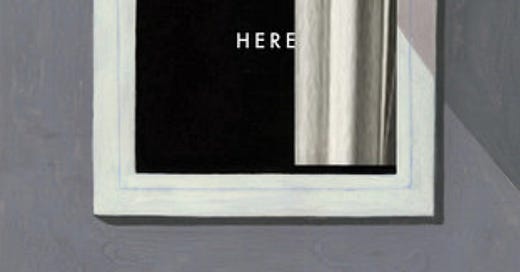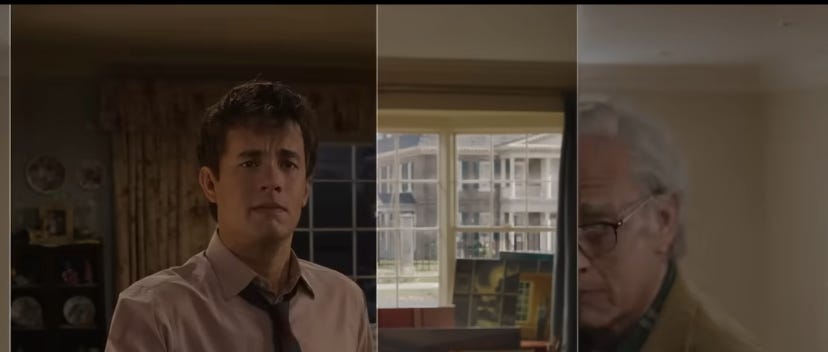HERE - SerioComics 50
HERE written and drawn by Richard McGuire, originally published in RAW, vol. 2 #1, then published by Pantheon + its 2024 film adaptation by Robert Zemeckis
From a 6 page Self-Published Comic to a 304 page Graphic Novel to a Major Motion Picture
Last week in an enthusiasm about BLANCAFLOR from TOON Books, I mentioned that Françoise Mouly and Art Spiegelman self-published RAW magazine throughout the 1980s, which featured experimental groundbreaking comics that became classics.
This week I happened to notice that one of those independently published classics, Richard McGuire’s HERE, which was originally a 6-page comic in RAW in 1989, but then became a 304-page graphic novel in 2014 published by Random House’s Pantheon, has a major motion picture film adaptation releasing in theaters today.

I decided to re-read the book last night and check out the film this morning for this week’s enthusiasm about the relationship between the two!
Richard McGuire
Richard McGuire (American, b. 1957) has produced an enormously diverse body of work in multiple media, characterized throughout by intelligence, wit, conceptual integrity, and the use of elegant, minimal design to communicate complicated ideas about the human experience.
McGuire first gained notice in the early 1980s as the bassist and founding member of the seminal post-punk band Liquid Liquid, for which he designed all of the posters and album artwork. One of their most famous tracks, Cavern, was appropriated by Grandmaster Flash and Melle Mel and became the hit song White Lines. The matter was resolved some years later in an out-of-court settlement.
Emerging from the downtown New York scene, where art and music co-mingled, McGuire’s street art was included in the 1981 exhibition New York/New Wave, at MoMA PS1, alongside the work of Keith Haring and Jean-Michel Basquiat.
McGuire has produced a small but important body of comics work, including the short story “Here” which appeared in Art Spiegelman and Françoise Mouly’s RAW Magazine in 1989. The piece reconfigured the way comics depict time and space and is recognized as a transformative work. It later became the basis for the graphic novel of the same name, published in 2014 by Pantheon Books. Here has since been translated into more than 20 languages. In 2016, it won the Fauve d'Or, the top award in France for graphic novels.
In 2022, it was announced that a film adaptation of Here would be directed by Robert Zemeckis, starring Tom Hanks and Robin Wright.
Throughout his career, McGuire’s artistic practice has remained multidisciplinary. He is an illustrator and longtime contributor to The New Yorker, for which he has produced numerous covers and interior illustrations. He has also written and illustrated several children’s books, designed toys and other products, created interactive media, and directed and designed animation, including the short film Micro Loup (2002) and the closing segment for the animated anthology film Fear(s) of the Dark (2007). In 2018, he exhibited 60 sculptures at The Aldrich Contemporary Art Museum, in Ridgefield, Connecticut.
All of McGuire’s work shares a simplified aesthetic, built out of minimal forms, often combined in dizzying ways. His approach to diagrammatic abstraction remains mindful of the relationship between line, shape, and form, and permits seamless shifts in scale and perspective even as it moves from medium to medium. McGuire’s work reorganizes perception to suggest larger connections between time, people, and places.
His work is included in the permanent collections of The Museum of Modern Art, The Metropolitan Museum of Art, The Morgan Library and Museum, and the Cooper Hewitt Smithsonian Design Museum.
This is his website.
HERE

Richard McGuire's comic Here appeared in Raw Magazine in 1989 and was quickly seen as a transformative work that expanded the possibilities of the comic medium…a work that has influenced…decades of comics art.
[Then came] an astonishing elaboration of McGuire’s original concept—the story of a corner of a room and of what happens in that space over time.
The book experiments with formal properties of comics, using multiple panels to convey different moments in the narrative.
Hundreds of thousands of years become interwoven. A dinosaur from 100,000,000 BCE lumbers by, while a child is playing with a plastic toy that resembles the same dinosaur in the year 1999. Conversations appear to be happening between two people who are centuries apart. Someone asking, "Anyone seen my car keys?" can be "answered" by someone at a future archaeology dig.
Cycles of glaciers transform into marshes, then into forests, then into farmland. A city develops and grows into a suburban sprawl. Climate change causes the land to submerge, if only temporarily, for the long view reveals the transient nature of all things. Meanwhile, the attention is focused on the most ordinary moments and appreciating them as the most transcendent.
From one of the great comic innovators, Here is the long-awaited fulfillment of a pioneering comic vision.
Film Has Remarkable Visual Formal Fidelity To Original
I really enjoyed the experience of watching this unique film adaptation of a graphic novel.
As The New York Times notes:
“Here is filmed almost entirely from one locked-off shot, with a camera positioned in what becomes the living room of a century-old New England home. There are no cutaways or traditional close-ups; no montages or wide-angle transitions. It’s an experiment in cinematic formalism.”
This is incredibly rare both in terms of cinematic formalism, but also in terms of the formalism of a graphic novel adaptations.
Because what it does is really capture the experience of looking at a static yet changing page.
Inventive Dialogue Reproduction and Repurposing
But the filmmaker of HERE, Robert Zemeckis, who brought back the same screenwriter, cinematographer, composer, and main two actors, Tom Hanks and Robin Wright, 30 years after 1994’s FORREST GUMP, for this adaptation, doesn’t just stop with this remarkable fidelity to the visual medium of the original graphic novel.
Zemeckis and Eric Roth and team also find exceedingly large ways to faithfully reproduce lines of dialogue from the original book.
They also repurpose lines to match the new narrative in similarly dutiful yet still inventive ways.
If you do go see the movie, I highly recommend reading the book beforehand, just to experience Zemeckis and the co-screenwriter Eric Roth’s loyal wizardry here.
From Cerebral and Detached to Human and Heartfelt
At the same time as there is all this immense formal fidelity to the original graphic novel, there is an addition and accretion of narrative that completely changes the tone.
McGuire’s book is cool. In the sense of the word as incredibly hip and fresh. But also in the sense that is often somewhat unfeeling or at least detached.
Zemeckis’ narrative contribution goes in the complete opposite direction, warm with sentimentality to the point of over-heated to some critics.
But I very much enjoyed the heartfelt new narrative and found it wonderfully affecting throughout and especially in the end.
Be Here Now Theme
This new narrative also seemed to add a new theme to the original book.
The main story that unfolds, without spoilers, has a lot to do with realizing in retrospect that you weren’t always present during the here and now.
There are scenes of conscious or unconscious desire to escape via alcohol and anger addiction or fears of money or failure as well as simply a desire to escape the home.
But there are also multiple minor and moderating storylines.
My favorite storyline has to do with an inventor and his romantic partner who pursue his dream and their love, without children.
You can often palpably sensate their engagement with the here and now.
A Note About AI
Much has also been written recently about how Zemeckis and his filmmaking team used a new generative artificial intelligence technology called Metaphysic to de-age or face-swap the actors in real time as they perform instead of using additional post-production processing methods.
What I found interesting about this was that Zemeckis uses it as a tool to enhance but not replace actual filmmaking.
This is also something that has been entering the comics and graphic novel space.
Like generative AI there are ranges to this.
From Lumi’s seemingly complete replacement of illustrators.
To something I’ve already done with my illustrator of SHOULD WE BUY A GUN? while working on our next potential project THE ENNEAGRAM SUPERHEROES.
In the four years we took to illustrate the first book, we often struggled with me trying to elucidate what I wanted him to draw because I had such limited art skills.
But with the first few pages of THE ENNEAGRAM SUPERHEROES, he proposed that I try for difficult pages not to only try to draw something or find images online but also to use AI to help envision it for him to then draw his version.
A Note About Hummingbirds, Squirrels and Synchronicity
As many of you are aware I hope for SHOULD WE BUY A GUN? to one day become a film.
And seeing Richard McGuire’s HERE’s 35-year journey from a 1989 comic to a 2014 book to a 2024 was inspiring but also humbling.
I may never get to accomplish this dream much like some of the characters in the film.
But I might be able to like some of the other characters in the film.
:)
I did notice that there were re-occurences of a hummingbird motif as well as the use of a squirrel symbol.
Which reminded me very much of something I did in SWBAG? to symbolize the husband and wife of the main couple.
Lastly, there was this wonderful moment in McGuire’s book about music synchronicities which reminded me of my other Substack, Shuffle Synchronicities.
So I’ll keep at it…
In the meantime, check out Richard McGuire’s book HERE available from the publisher or Amazon or go see the film adaptation by Robert Zemeckis now playing.

















